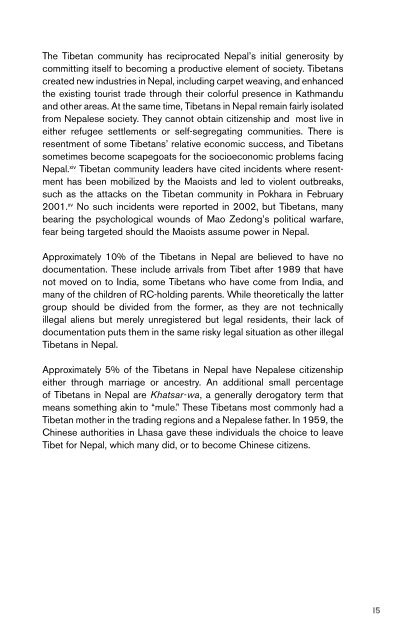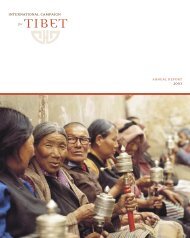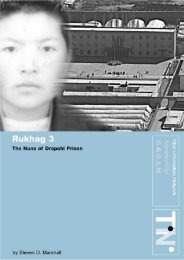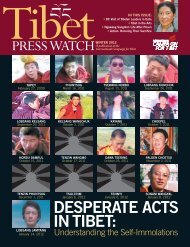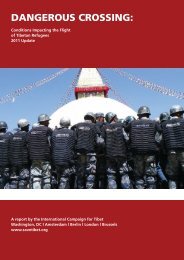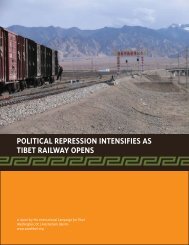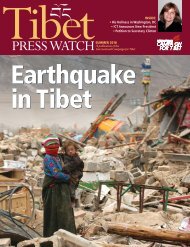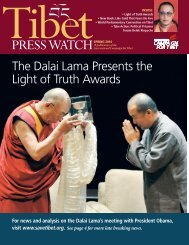download the report - International Campaign for Tibet
download the report - International Campaign for Tibet
download the report - International Campaign for Tibet
- No tags were found...
You also want an ePaper? Increase the reach of your titles
YUMPU automatically turns print PDFs into web optimized ePapers that Google loves.
The <strong>Tibet</strong>an community has reciprocated Nepal’s initial generosity bycommitting itself to becoming a productive element of society. <strong>Tibet</strong>anscreated new industries in Nepal, including carpet weaving, and enhanced<strong>the</strong> existing tourist trade through <strong>the</strong>ir colorful presence in Kathmanduand o<strong>the</strong>r areas. At <strong>the</strong> same time, <strong>Tibet</strong>ans in Nepal remain fairly isolatedfrom Nepalese society. They cannot obtain citizenship and most live inei<strong>the</strong>r refugee settlements or self-segregating communities. There isresentment of some <strong>Tibet</strong>ans’ relative economic success, and <strong>Tibet</strong>anssometimes become scapegoats <strong>for</strong> <strong>the</strong> socioeconomic problems facingNepal. xiv <strong>Tibet</strong>an community leaders have cited incidents where resentmenthas been mobilized by <strong>the</strong> Maoists and led to violent outbreaks,such as <strong>the</strong> attacks on <strong>the</strong> <strong>Tibet</strong>an community in Pokhara in February2001. xv No such incidents were <strong>report</strong>ed in 2002, but <strong>Tibet</strong>ans, manybearing <strong>the</strong> psychological wounds of Mao Zedong’s political warfare,fear being targeted should <strong>the</strong> Maoists assume power in Nepal.Approximately 10% of <strong>the</strong> <strong>Tibet</strong>ans in Nepal are believed to have nodocumentation. These include arrivals from <strong>Tibet</strong> after 1989 that havenot moved on to India, some <strong>Tibet</strong>ans who have come from India, andmany of <strong>the</strong> children of RC-holding parents. While <strong>the</strong>oretically <strong>the</strong> lattergroup should be divided from <strong>the</strong> <strong>for</strong>mer, as <strong>the</strong>y are not technicallyillegal aliens but merely unregistered but legal residents, <strong>the</strong>ir lack ofdocumentation puts <strong>the</strong>m in <strong>the</strong> same risky legal situation as o<strong>the</strong>r illegal<strong>Tibet</strong>ans in Nepal.Approximately 5% of <strong>the</strong> <strong>Tibet</strong>ans in Nepal have Nepalese citizenshipei<strong>the</strong>r through marriage or ancestry. An additional small percentageof <strong>Tibet</strong>ans in Nepal are Khatsar-wa, a generally derogatory term thatmeans something akin to “mule.” These <strong>Tibet</strong>ans most commonly had a<strong>Tibet</strong>an mo<strong>the</strong>r in <strong>the</strong> trading regions and a Nepalese fa<strong>the</strong>r. In 1959, <strong>the</strong>Chinese authorities in Lhasa gave <strong>the</strong>se individuals <strong>the</strong> choice to leave<strong>Tibet</strong> <strong>for</strong> Nepal, which many did, or to become Chinese citizens.15


